The Health Education Assets Library (HEAL) is a collection of over 22,000 freely available digital materials for health sciences education. The collection is now housed at the University of Utah J. Willard Marriott Digital Library.
TO
| Title | Description | Subject | Collection | ||
|---|---|---|---|---|---|
| 101 |
 |
Cranial Nerve Exam: Abnormal Examples: Smooth Pursuit | The patient shown has progressive supranuclear palsy. As part of this disease there is disruption of fixation by square wave jerks and impairment of smooth pursuit movements. Saccadic eye movements are also impaired. Although not shown in this video, vertical saccadic eye movements are usually the i... | Cranial Nerve Examination | NeuroLogic Exam: An Anatomical Approach |
| 102 |
 |
Cranial Nerve Exam: Abnormal Examples: Smooth Pursuit (x2) | The patient shown has progressive supranuclear palsy. As part of this disease there is disruption of fixation by square wave jerks and impairment of smooth pursuit movements. Saccadic eye movements are also impaired. Although not shown in this video, vertical saccadic eye movements are usually the i... | Cranial Nerve Examination | NeuroLogic Exam: An Anatomical Approach |
| 103 |
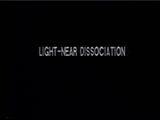 |
Cranial Nerve Exam: Abnormal Examples: Vergence | Light-near dissociation occurs when the pupils don't react to light but constrict with convergence as part of the near reflex. This is what happens in the Argyll-Robertson pupil (usually seen with neurosyphilis) where there is a pretectal lesion affecting the retinomesencephalic afferents controllin... | Cranial Nerve Examination | NeuroLogic Exam: An Anatomical Approach |
| 104 |
 |
Cranial Nerve Exam: Abnormal Examples: Vergence (x2) | Light-near dissociation occurs when the pupils don't react to light but constrict with convergence as part of the near reflex. This is what happens in the Argyll-Robertson pupil (usually seen with neurosyphilis) where there is a pretectal lesion affecting the retinomesencephalic afferents controllin... | Cranial Nerve Examination | NeuroLogic Exam: An Anatomical Approach |
| 105 |
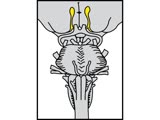 |
Cranial Nerve Exam: Anatomy: Cranial Nerve 1 | Olfaction is the only sensory modality with direct access to cerebral cortex without going through the thalamus. The olfactory tracts project mainly to the uncus of the temporal lobes. NeuroLogic Exam has been supported by a grant from the Slice of Life Development Fund at the University of Utah, th... | Cranial Nerve Examination | NeuroLogic Exam: An Anatomical Approach |
| 106 |
 |
Cranial Nerve Exam: Anatomy: Cranial Nerve 1 (x2) | Olfaction is the only sensory modality with direct access to cerebral cortex without going through the thalamus. The olfactory tracts project mainly to the uncus of the temporal lobes. NeuroLogic Exam has been supported by a grant from the Slice of Life Development Fund at the University of Utah, th... | Cranial Nerve Examination | NeuroLogic Exam: An Anatomical Approach |
| 107 |
 |
Cranial Nerve Exam: Anatomy: Major Oculomotor Gaze Systems | Eye movements are controlled by 4 major oculomotor gaze systems, which are tested for on the neurological exam. They are briefly outlined here: Saccadic (frontal gaze center to PPRF (paramedian pontine reticular formation) for rapid eye movements to bring new objects being viewed on to the fovea. Sm... | Cranial Nerve Examination | NeuroLogic Exam: An Anatomical Approach |
| 108 |
 |
Cranial Nerve Exam: Anatomy: Major Oculomotor Gaze Systems (x2) | Eye movements are controlled by 4 major oculomotor gaze systems, which are tested for on the neurological exam. They are briefly outlined here: Saccadic (frontal gaze center to PPRF (paramedian pontine reticular formation) for rapid eye movements to bring new objects being viewed on to the fovea. Sm... | Cranial Nerve Examination | NeuroLogic Exam: An Anatomical Approach |
| 109 |
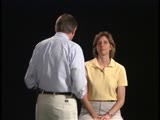 |
Cranial Nerve Exam: Normal Exam: Vergence | Vergence eye movements occur when the eyes move simultaneously inward (convergence) or outward (divergence) in order to maintain the image on the fovea that is close up or far away. Most often convergence is tested as part of the near triad. When a patient is asked to follow an object that is brough... | Cranial Nerve Examination; Vergence | NeuroLogic Exam: An Anatomical Approach |
| 110 |
 |
Cranial Nerve Exam: Normal Exam: Vergence (x2) | Vergence eye movements occur when the eyes move simultaneously inward (convergence) or outward (divergence) in order to maintain the image on the fovea that is close up or far away. Most often convergence is tested as part of the near triad. When a patient is asked to follow an object that is brough... | Cranial Nerve Examination; Vergence | NeuroLogic Exam: An Anatomical Approach |
| 111 |
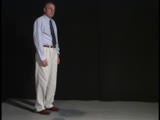 |
Gait Exam: Abnormal Examples: Hemiplegic Gait Demonstration | The patient has unilateral weakness and spasticity with the upper extremity held in flexion and the lower extremity in extension. The foot is in extension so the leg is too long therefore, the patient will have to circumduct or swing the leg around to step forward. This type of gait is seen with a U... | Gait Examination; Hemiplegic Gait | NeuroLogic Exam: An Anatomical Approach |
| 112 |
 |
Gait Exam: Abnormal Examples: Hemiplegic Gait Demonstration | The patient has unilateral weakness and spasticity with the upper extremity held in flexion and the lower extremity in extension. The foot is in extension so the leg is too long therefore, the patient will have to circumduct or swing the leg around to step forward. This type of gait is seen with a U... | Gait Examination; Hemiplegic Gait | NeuroLogic Exam: An Anatomical Approach |
| 113 |
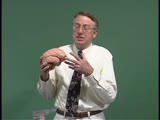 |
Gait Exam: Anatomy: Introduction | All levels of the neuroaxis contribute to gait although most gait abnormalities are motor in nature. In assessing gait it is important to not only watch the lower extremities but also the upper extremities for normal associated movements. NeuroLogic Exam has been supported by a grant from the Slice ... | Gait Examination | NeuroLogic Exam: An Anatomical Approach |
| 114 |
 |
Gait Exam: Anatomy: Localizing Value | There are 7 basic pathological gaits that should be recognized by their characteristic pattern. These pathological gaits are: - Hemiplegic - Spastic diplegic - Neuropathic - Myopathic - Parkinsonian - Chorea - Ataxic These gaits have localizing value because they can indicate levels (an y axis a... | Gait Examination; Hemiplegic Gait; Spastic Diplegia; Neuropathic Gait; Myopathic Gait; Diplegic Gait | NeuroLogic Exam: An Anatomical Approach |
| 115 |
 |
Gait Exam: Anatomy: Localizing Value | There are 7 basic pathological gaits that should be recognized by their characteristic pattern. These pathological gaits are: - Hemiplegic - Spastic diplegic - Neuropathic - Myopathic - Parkinsonian - Chorea - Ataxic These gaits have localizing value because they can indicate levels (an y axis a... | Gait Examination; Hemiplegic Gait; Spastic Diplegia; Neuropathic Gait; Myopathic Gait; Diplegic Gait | NeuroLogic Exam: An Anatomical Approach |
| 116 |
 |
Gait Exam: Normal Exam: Heel and Toe Walking | A good way to test balance as well as strength of the distal lower extremities is to have the patient heel and toe walk. NeuroLogic Exam has been supported by a grant from the Slice of Life Development Fund at the University of Utah, the Department of Pediatrics and the Office of Education at the Un... | Gait Examination; Heel-toe Gait | NeuroLogic Exam: An Anatomical Approach |
| 117 |
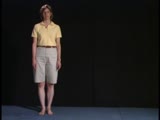 |
Gait Exam: Normal Exam: Natural Gait | The patient should be able to walk with a smooth, coordinated gait. There should be normal associated movement of the upper extremities. NeuroLogic Exam has been supported by a grant from the Slice of Life Development Fund at the University of Utah, the Department of Pediatrics and the Office of Edu... | Gait Examination; Natural Gait | NeuroLogic Exam: An Anatomical Approach |
| 118 |
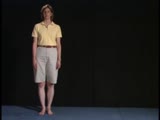 |
Gait Exam: Normal Exam: Station | The patient should be able to stand still with her feet less then shoulder width apart. NeuroLogic Exam has been supported by a grant from the Slice of Life Development Fund at the University of Utah, the Department of Pediatrics and the Office of Education at the University of Nebraska Medical Cent... | Gait Examination; Station | NeuroLogic Exam: An Anatomical Approach |
| 119 |
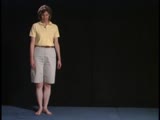 |
Gait Exam: Normal Exam: Tandem Gait | Have the patient walk heel-to-toe. The patient should be able to balance without falling or stepping to the side. NeuroLogic Exam has been supported by a grant from the Slice of Life Development Fund at the University of Utah, the Department of Pediatrics and the Office of Education at the Universit... | Gait Examination; Heel-toe Gait | NeuroLogic Exam: An Anatomical Approach |
| 120 |
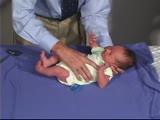 |
PediNeuroLogic Exam: Newborn: Normal: Primitive Reflexes - Galant | The Galant reflex (trunk incurvation) is obtained by placing the baby in ventral suspension, then stroking the skin on one side of the back. The baby's trunk and hips should swing towards the side of the stimulus. PediNeuroLogic Exam has been supported by a grant from the Slice of Life Developmen... | PediNeuroLogic Exam | |
| 121 |
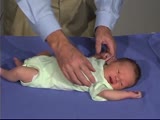 |
PediNeuroLogic Exam: Newborn: Normal: Tone - Arm Recoil (x2) | Arm recoil tests tone and action of the biceps. The arms are held in flexion against the chest for a few seconds, then are quickly extended and released. The arms should spring back to the flexed position. The hypotonic infant will have slow incomplete recoil. Asymmetry to this response with lack of... | PediNeuroLogic Exam | |
| 122 |
 |
The Accommodation Reflex | This three minute video describes and animates the events taking place in the eye during accommodation. Narration describes the events. Three dimensional animation shows convergence of the eyes. The view changes to a cut-away view of the eye interior to show pupillary constriction and changes in the... | Near Triad; Pupillary Constriction; Ciliary Muscle | HEAL Reviewed Collection |
| 123 |
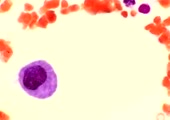 |
Thrombogenesis | Megakarocyte morphogenesis and platelet formation. | Thrombogenesis | HEAL Reviewed Collection |
